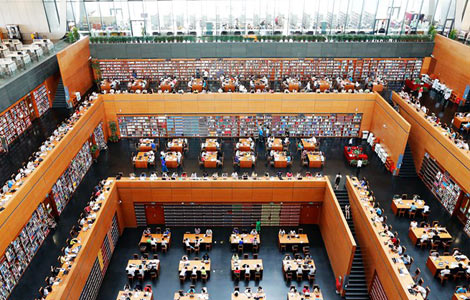Moroccan magic
Updated: 2015-05-07 07:51
By Mike Peters(China Daily)
|
|||||||||||
Chef Najat Kaanache is another unofficial culinary ambassador of Morocco, sharing flavors and cooking techniques with many top chefs in Spain, Denmark, the Netherlands and the US.
Morocco's most famous dish is couscous, a staple food across North Africa made from semolina (durum wheat) cooked by steaming. It's traditionally served with a meat or vegetable stew ladled on top, and it's been documented in cookbooks and histories written as long ago as the 13th century.
Properly cooked, it's light and fluffy. Instant couscous is widely available; pre-steamed, it can be cooked in about five minutes, taking less time to prepare than regular couscous, most dried pastas or rice.
Another Moroccan dish that's made its way around the globe is the tagine, a savory stew named after the distinctive clay pot used for cooking it. The traditional wide clay vessel has two parts, a flat, circular base with low sides and a cone-shaped cover designed to return all condensation to the bottom. Large bricks of hot charcoal are traditionally used for cooking tagine; the pot is positioned a bit above the coals so the temperature doesn't rise too fast. Pickled lemons, a Moroccan delicacy, are often used to add a bit of sass to chicken tagine.
Fruits populate many Moroccan dishes. Prunes and apricots are favored with lamb, reflecting traditions of drying and pickling that go back to Silk Road days, when traders needed foods "to go" that would go for literally weeks. Raisins are popular in dishes with every kind of meat.
No Moroccan meal is complete without Maghrebi mint tea, a green tea prepared with spearmint leaves and sugar. Combining imported ingredients (tea from China and originally imported sugar) and a local ingredient (fresh mint), food historians say it is an early example of globalization in cuisine. The serving of mint tea can take a ceremonial form, especially when prepared for a guest. Traditionally the head of family prepares it and serves to the guest.
In China, Moroccan restaurants tend to be small and intimate.
"It's really cozy," says local Australian expat Tony Miller, a restaurant regular who studied Arabic in Rabat for several years. "You always feel like you're eating with family and friends, and that's just how it's supposed to feel."
About this series
China Daily is featuring different cuisines from countries along the Silk Road every Thursday.
Related Stories
China's first 3D Peking Opera film debuts in Shanghai 2015-05-06 10:47
Director Feng touts film with edgy laughs 2015-05-06 06:08
Director appeals to audience for support of arthouse film 2015-05-04 08:59
5th Beijing International Film Festival closes 2015-04-24 11:07
Film Festival ends with honors, acclaim 2015-04-24 04:26
Today's Top News
Rolling stock company forges ahead in Russia
Denmark receives 3 bomb threats in one day: media
Bilateral efforts 'inject fresh impetus'
Chinese researcher wins Heinz Maier-Leibnitz Prize in Germany
Reasons behind Russia's high-profile V-Day celebrations
Wang Jianlin: Asia's richest man
China regulator denies Siemens bribery probe
Milan-Shanghai flight to 'establish important bridge'
Hot Topics
Lunar probe , China growth forecasts, Emission rules get tougher, China seen through 'colored lens', International board,
Editor's Picks

|

|

|

|

|

|






